Innovative Kitchen Renovation Ideas for 2021
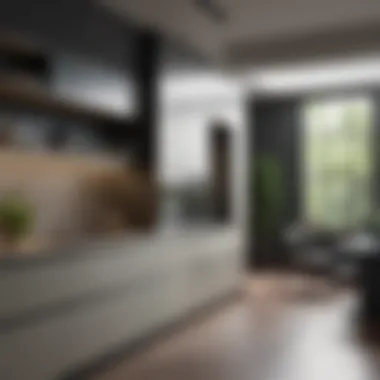

Intro
Renovating a kitchen is not just about aesthetics; it’s also about creating a space that is functional and enjoyable. This year, numerous innovative ideas are emerging in the realm of kitchen renovation. These concepts not only beautify the kitchen but also improve how it serves the needs of homeowners. From color choices to material selections, each aspect plays a significant role in the overall transformation of this key area in the home.
Exploring new trends in design goes hand-in-hand with identifying sustainable practices, which is becoming increasingly important in modern renovations. Understanding these factors can help in making informed decisions that enhance the kitchen experience. This guide will navigate through various aspects of kitchen renovation ideas for 2021, providing valuable insights to inspire and educate homeowners and interior design enthusiasts alike.
Design Inspiration
Current Trends in Interior Design
When discussing kitchen renovations, current trends are essential to consider. This year, open-concept designs are still in vogue, offering a spacious feel by combining the kitchen with living areas. Minimalist designs that focus on essential elements without clutter also continue to gain popularity. These styles aim to create a calming environment that invites participation, whether for cooking or entertaining.
Natural materials are prominent, with wood and stone being favored for their timeless quality and warmth. These materials evoke a sense of comfort while also providing durability.
Another notable trend revolves around smart technology integration. Homeowners increasingly seek kitchens equipped with smart appliances, such as refrigerators that can track grocery inventory or ovens that can be controlled via smartphone apps. These features enhance convenience and efficiency in daily tasks.
Color Schemes and Palette Ideas
Color selection is crucial when creating a stunning kitchen. This year, soft earth tones are trending. Colors like sage green and muted blues provide a serene backdrop and evoke nature. These shades often pair well with wooden surfaces, adding to the organic feel.
Bright accents can be introduced through smaller elements, such as kitchen accessories or bar stools. A splash of mustard yellow or deep navy can create a striking contrast without overwhelming the inherent tranquility of the space.
For those preferring a bolder approach, all-black kitchens are making a powerful statement in contemporary design. When done well, it can produce an elegant and sophisticated atmosphere.
"The kitchen is the heart of the home; its design should reflect both functionality and individual style."
Understanding Kitchen Renovation
Kitchen renovation is not just about aesthetics. The act of remodeling this vital space in your home can bring numerous rewards. This section aims to dissect the underlying principles of kitchen renovation. Knowing the purpose and benefits can guide homeowners in making informed decisions.
Purpose of Kitchen Renovation
The purpose of kitchen renovation varies from one homeowner to another. Generally, people aim to create a space that meets modern needs while reflecting personal style. As families grow or lifestyles change, the kitchen often requires updates to accommodate these shifts.
Renovation serves to enhance functionality. Older kitchens may not have adequate workspace or storage. A well-planned remodel can improve these aspects. Moreover, upgrading outdated appliances and layouts can lead to increased energy efficiency, providing long-term cost savings.
Additionally, personal tastes evolve. Homeowners might find their current kitchen no longer aligns with their vision. Renovating enables individuals to express their creativity and cater the space to their preferences.
Key Benefits of Renovating Your Kitchen
Renovating your kitchen carries several significant benefits. Here are some key points:
- Increased Property Value: A renovated kitchen often enhances the overall appeal of a home. If you plan to sell, modern features and a fresh look can attract higher offers.
- Improved Functionality: Updates can resolve issues like inadequate space for cooking or dining. Tailoring the layout can ensure the kitchen serves its intended purpose effectively.
- Enhanced Energy Efficiency: New appliances can save considerable energy, leading to lower bills. If you choose sustainable materials, you make an eco-conscious choice that benefits both you and the environment.
- Stylish Aesthetics: Updating finishes, colors, and fixtures can dramatically change the kitchen’s look. A cohesive style enhances the overall ambiance of your home.
- Tailored Design: Customization allows you to incorporate features that suit your needs. Whether it is a more functional island or open shelving to display collectibles, the choices are extensive.
"A successful kitchen renovation combines practicality with personal style, resulting in a space that feels both functional and emotionally resonant."
Current Trends in Kitchen Design
The realm of kitchen design is constantly evolving, influenced by changes in lifestyle, technology, and environmental factors. Recognizing current trends in kitchen design for 2021 is crucial for homeowners looking to create a functional and aesthetically pleasing space. Not only does it provide insights into what’s popular, but it also guides decisions that enhance overall living quality. Welcome to a modern kitchen that’s not merely a place for cooking but also an inviting area for social interaction and relaxation.
Popular Color Schemes for
In 2021, color schemes play an essential role in transforming the kitchen and setting the ambiance. Soft, muted tones such as sage green, blush pink, and light gray are popular. They offer a sense of tranquility while being stylish. These shades can make the space feel larger and lightened up, creating an atmosphere conducive to cooking and gathering. On the other hand, bold colors like navy blue and deep emerald are making a comeback, often used on cabinetry or accent walls to create a strong statement. When selecting colors, it's vital to consider natural lighting, the overall size of the kitchen, and furnishings that will complement the palette.
Here are some popular combinations to consider:
- White and Gold: For a sleek, modern look.
- Gray with Bright Accents: Incorporating vibrant colors through decor elements.
- Monochrome Schemes: Using different shades of one color can add depth without overwhelming.
"Color is a power which directly influences the soul." – Wassily Kandinsky
Incorporating Sustainable Materials
Sustainability is a prominent trend in kitchen design. Homeowners are now more conscious about the environmental impact of their renovation choices. Incorporating sustainable materials not only contributes to an eco-friendly kitchen but also promotes healthier indoor air quality. Some favored materials include reclaimed wood, bamboo, and recycled glass. These options are not only durable but also bring unique textures and visual interest to the kitchen.
When selecting materials, consider the following factors:
- Source and Sustainability: Look for certifications such as FSC (Forest Stewardship Council) or similar to ensure responsible sourcing.
- Longevity: Sustainable does not always mean more expensive; consider the lifespan of the materials, as sustainability often correlates with durability.
- Aesthetic Appeal: Choose materials that fit well with your overall design vision. They should complement other elements in your kitchen like cabinetry and fixtures.
Emphasizing Minimalism
Minimalism continues to influence kitchen design in 2021. A minimalist approach embraces simplicity and functionality. It often translates into clean lines, uncluttered counters, and a streamlined appearance. The focal point in a minimalist kitchen can often be a statement piece, such as a stylish countertop or unique faucet, rather than individual decorative items cluttering the space.
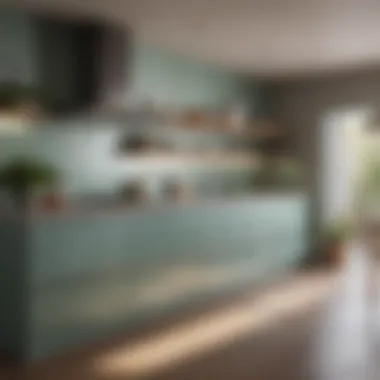
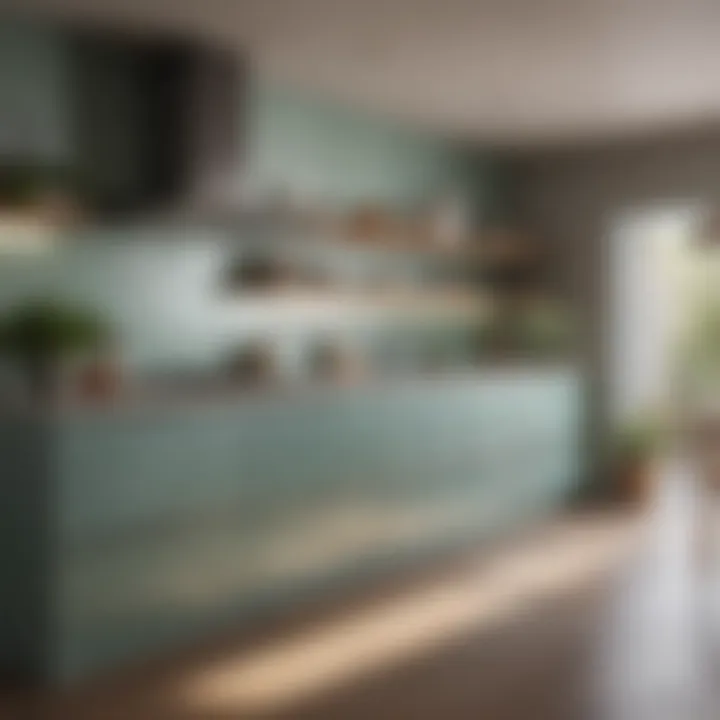
Key principles of minimalist design include:
- Functional Furniture: Choose furniture and appliances that serve multiple purposes without excessive ornamentation.
- Quality over Quantity: Invest in fewer high-quality pieces rather than filling the space with many low-quality items. This approach enhances the overall feel of the kitchen.
- Smart Storage Solutions: Incorporating hidden storage can maintain a clean appearance and reduce clutter without sacrificing accessibility.
Overall, the current kitchen design trends of 2021 revolve around creating a space that is not only visually appealing but also functional, sustainable, and reflective of personal style.
Functional Layouts to Consider
Functional layouts are essential when renovating a kitchen. The design of the kitchen affects not just aesthetics, but also ease of use. A well-thought-out layout can improve workflow and maximize space, making meal preparation and entertaining more efficient. Understanding different layouts can help homeowners choose one that fits their lifestyle and enhances the kitchen's overall utility.
The Open-Concept Kitchen
The open-concept kitchen continues to gain popularity. This layout integrates the kitchen with adjacent living spaces, such as the dining room or living room. It allows for easier interaction among family members and guests while cooking. The lack of walls opens up natural light, creating a brighter atmosphere. Key benefits include:
- Increased social interaction: No barriers mean hosts can engage with guests while preparing food.
- Flexible space: Allows for furniture arrangement changes to suit various gatherings.
- Visual appeal: The continuous flow fosters a more spacious feel.
However, homeowners should consider how to manage noise and cooking odors. Thoughtful placement of cooking zones and ventilation can mitigate some concerns.
U-Shaped and L-Shaped Designs
U-shaped and L-shaped kitchens are timeless layouts that focus on efficiency. Both options provide ample counter and cabinet space, which is crucial for storage and food preparation.
- U-Shaped Design: This layout forms a U-shape and is ideal for larger spaces. These kitchens typically offer:
- L-Shaped Design: This configuration wraps around two adjacent walls. It works well in smaller kitchens while maintaining function. Benefits include:
- Three walls of cabinets and appliances: Greater storage and work surfaces.
- Efficient workflow: The classic work triangle of the stove, sink, and refrigerator remains intact.
- Open feel: The design allows for an easy flow into the adjoining rooms.
- Versatile layouts: Space can double as dining area, especially when combined with an island or a dining table.
When choosing between these shapes, homeowners should evaluate their kitchen size and desired flow within the space.
Incorporating an Island
A kitchen island can enhance functionality significantly. It provides additional workspace, storage, and social interaction. Several benefits of adding an island include:
- Extra preparation space: An island gives more room to cook, bake, or prepare meals. This is especially useful in busy households.
- Seating options: Many islands allow for bar stools, providing a casual dining area.
- Integrated storage: Islands can house cabinets and shelves, helping maintain order in the kitchen.
To effectively incorporate an island, consider its size and proportions relative to the existing kitchen layout. An overly large island can disrupt traffic flow and accessibility.
A well-designed kitchen layout prioritizes functionality and easy movement, ensuring a pleasant cooking experience.
Innovative Storage Solutions
In the world of kitchen renovation, effective storage solutions are paramount. As kitchens often serve as the heart of the home, it is essential to design spaces that blend style with functionality. Innovative storage can transform not only the physical layout of a kitchen but also how it feels to work in. With clever storage strategies, one can increase organization, reduce clutter, and enhance the overall aesthetic. Utilizing such solutions can also make a kitchen more adaptable to the changing needs of a household.
Maximizing Cabinet Space
Cabinet space is a critical resource in any kitchen. One effective method for maximizing this space is through the use of pull-out shelves or drawer systems. These allow for easy access to items that would otherwise be difficult to retrieve, especially in the back of deep cabinets. Another strategy includes vertical dividers within cabinets. This approach provides dedicated areas for pots, pans, and baking sheets, facilitating better organization.
Employing stackable storage solutions can also be beneficial. Stackable bins or containers keep smaller items safe while using height for better space utilization. Furthermore, by choosing cabinets that extend to the ceiling, homeowners can utilize every inch of available space. This move not only increases storage but also creates a visually appealing finished look.
Using Open Shelving
Open shelving has gained popularity in recent years as a viable storage option. It allows homeowners to display attractive dishware or decorative items while keeping frequently used cooking essentials within reach. One advantage of open shelving is that it encourages an organized kitchen environment, as the visibility of items promotes tidiness.
However, it requires careful consideration of what items to display. The suggestion is to choose items that blend well with the overall kitchen theme. It could be rustic wooden shelves or sleek metal ones that can enhance decor. This type of storage also encourages a minimalist approach, reducing the number of items in sight, which can create a lighter aesthetic.
Creating Hidden Storage Areas
Hidden storage areas can dramatically increase the kitchen's functionality while maintaining a clean look. Innovative designs such as creating drawers under appliances, for example, can provide an unexpected storage solution. Additionally, toe-kick drawers can utilize the space beneath cabinets for items like baking sheets and dish towels that are often disregarded.
Another fascinating idea is to incorporate storage into islands or peninsulas. By placing cabinets that can be easily opened from either side, one could create a space-saver in the middle of the room. Furthermore, utilizing the area behind cabinet doors with organizers or racks can effectively double up on storage potential without sacrificing style. The incorporation of these hidden areas ensures that every inch of space in the kitchen is used productively.
Lighting Trends for Modern Kitchens
Lighting is a crucial aspect of kitchen renovation, influencing both the functionality and aesthetic appeal of the space. In 2021, various trends emerged that elevate kitchen design through innovative lighting solutions. The right lighting not only enhances visibility but also sets the mood, reflects personal style, and integrates seamlessly with other design elements. As kitchens continue to evolve into multifunctional spaces, understanding the trends in lighting helps homeowners make informed decisions, thus creating a harmonious and welcoming environment.
Incorporating Natural Light
One of the most sought-after features in modern kitchens is the incorporation of natural light. Maximizing sunlight can transform a cooking space into a vibrant hub. Homeowners are increasingly opting for larger windows and skylights to invite more daylight indoors.
Benefits:
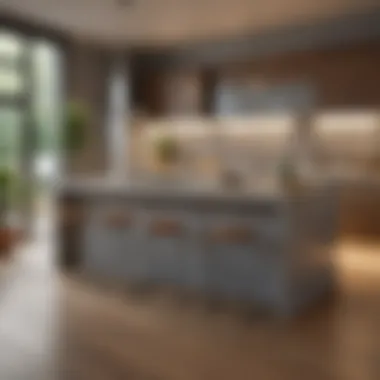
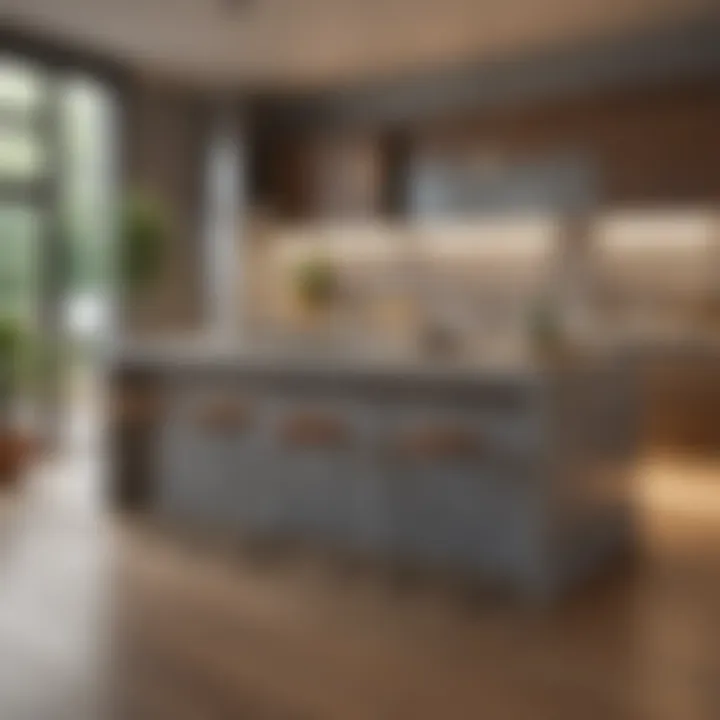
- Enhanced Mood: Natural light has a profound effect on emotional well-being.
- Energy Efficiency: Utilizing natural lighting reduces reliance on artificial sources, potentially lowering electricity bills.
- Visual Warmth: Sunlight can create a bright and inviting atmosphere in kitchens, making them more pleasant.
Considerations:
- Placement of windows should consider sunlight direction to avoid overheating.
- Use of sheer curtains can diffuse direct sunlight while maintaining privacy.
Using Pendant Lighting Effectively
Pendant lighting continues to be a popular choice for kitchen designs in 2021. These fixtures not only illuminate specific areas but also serve as decorative pieces. When placed over islands or countertops, they establish focal points in the kitchen.
Benefits:
- Versatility: Pendant lights come in various styles, colors, and sizes to complement any design.
- Task Lighting: They provide targeted lighting for cooking and food preparation tasks, enhancing visibility.
- Layering Effects: Adding multiple pendants can create a visually dynamic and interesting space.
Design Tips:
- Choose fixtures that match the kitchen's overall theme, whether modern, rustic, or traditional.
- Group pendants in odd numbers, typically three for a balanced look.
Layering Your Lighting Design
Layering lighting design is essential to create a well-illuminated kitchen. Instead of relying on a single source of light, combining ambient, task, and accent lighting results in a comprehensive approach that enhances function while adding depth to the overall design.
Key Components:
- Ambient Lighting: General illumination which provides overall brightness. This can come from ceiling lights or LED panels.
- Task Lighting: Focused lighting for specific areas, such as pendant lights or under-cabinet fixtures.
- Accent Lighting: Emphasizes certain features, like artwork or architectural elements through the use of spotlights or wall sconces.
Benefits:
- Versatility: Different lighting types allow homeowners to customize brightness according to the time of day and activity.
- Aesthetic Appeal: Layering creates a visually pleasing environment, allowing for creativity in design.
"A well-lit kitchen is not just functional; it contributes significantly to the culinary experience and social interactions that occur in this space."
In summary, understanding lighting trends for modern kitchens in 2021 is vital for any renovation. From natural light incorporation to effective use of pendant lighting and layering designs, these elements come together to enhance both utility and style, creating a truly innovative kitchen.
Selecting the Right Appliances
Choosing the right appliances for your kitchen is a crucial aspect of any renovation project. The appliances serve not only functional purposes but also tie the overall design together. When making your selections, focus on how they contribute to both the aesthetic and usability of your kitchen. This ensures that the items you choose enhance your cooking experience while fitting seamlessly into the layout and design.
Energy-Efficient Options
Energy-efficient appliances are gaining popularity as consumers become more conscious of their environmental impact. These options are designed to use less power, which can lead to significant savings on utility bills over time. When considering energy-efficient appliances, look for those that feature the Energy Star label. This indicates that they meet energy-saving standards set by the Environmental Protection Agency.
Benefits of energy-efficient appliances include:
- Cost savings on electricity bills.
- Reduced carbon footprint, contributing positively to the environment.
- Longer lifespan, as these appliances are built with high-quality components to withstand usage.
Investing in appliances like the Samsung 28 cu. ft. Side-by-Side refrigerator, known for its efficiency, can be a smart choice. Additionally, consider induction cooktops like the Bosch 800 Series, which not only cook faster but also consume less energy compared to traditional gas or electric models.
Smart Kitchen Technology
The integration of smart technology in the kitchen revolutionizes how you interact with your appliances. Smart appliances allow for increased convenience and enhanced control over your kitchen tasks. Features often include connectivity to mobile apps, voice control compatibility, and automated settings.
When selecting smart appliances, consider the following:
- Compatibility with your existing smart home systems, like Amazon Alexa or Google Assistant.
- User interface - ease of use matters, especially when family members with different tech savviness are involved.
- Upgradability of software to ensure longevity and adaptability to new technologies in the future.
Appliances like the LG Smart Oven allow you to preheat or adjust cooking settings remotely. Additionally, the GE Profile Smart Refrigerator offers features like water and ice dispensers, multiple cooking modes, and integrated Wi-Fi to keep your kitchen connected.
"Investing in the right appliances not only enhances the kitchen's look but can also improve overall energy management and functionality."
Finishing Touches and Decor
Finishing touches and decor are crucial components of any kitchen renovation. They provide the details that complete the overall aesthetic and functionality of the space. Many homeowners often overlook these elements, focusing primarily on larger renovations such as cabinets and appliances. However, effective decor can elevate the kitchen from merely functional to extraordinarily welcoming and sophisticated. Choosing appropriate decor can enhance the beauty of your renovations while reflecting your personal style and lifestyle choices.
Choosing the Right Countertops
Countertops serve as a central feature in the kitchen. The right choice can significantly influence the overall vibe of the room. When selecting countertops, consider materials like granite, quartz, and marble. Each option offers distinct advantages:
- Granite: Highly durable and heat resistant. Unique, natural patterns create a one-of-a-kind look.
- Quartz: Engineered and non-porous; it resists stains and bacteria, making it easy to maintain.
- Marble: Offers a luxurious appeal. However, it is more susceptible to scratches and stains.
Additionally, think about color. Light colors can make a small kitchen feel larger and airier. Darker hues often add a touch of richness and elegance. Ultimately, the choice should reflect your kitchen's overall design and your functional needs.
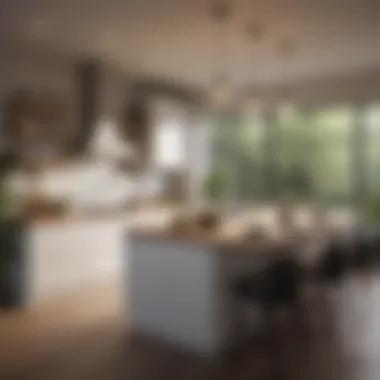
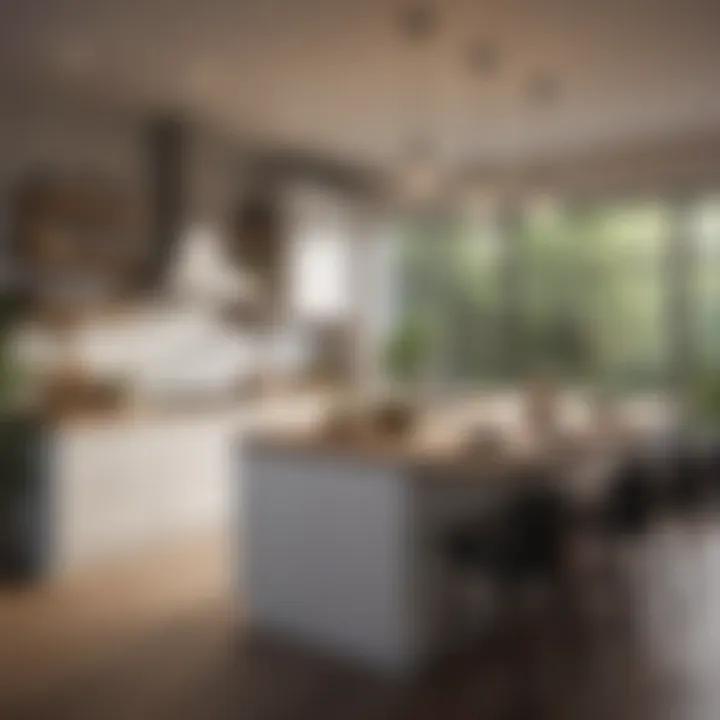
Backsplash Designs
A backsplash is not only practical but also serves as a focal point in kitchen decor. When considering backsplash designs, several options come to mind.
Popular materials include
- Subway Tile: Timeless, versatile, and easy to clean. Classic white or colored variants suit various styles.
- Glass: Adds a modern touch. Glass tiles reflect light, making spaces feel more expansive.
- Natural Stone: Advocacy for a rustic or organic look. Each stone is unique and tells its own story.
When choosing a design, consider how the backsplash complements both countertops and cabinetry. Keep in mind that it also provides an opportunity to incorporate color or pattern without overwhelming the space.
Key Tip: A well-chosen backsplash can act as the perfect bridge between differing elements of your kitchen, harmonizing the design in an impactful way.
Budgeting for Your Kitchen Renovation
Budgeting is a key component of any successful kitchen renovation. Having a realistic budget not only sets the stage for the entire project but also guides decisions throughout the process. Without proper financial planning, homeowners may find themselves encountering unexpected costs that can derail the renovation.
A well-thought-out budget ensures that you allocate funds appropriately for essential elements. It also helps prevent overspending, which can lead to stress and dissatisfaction with the project outcomes. Understanding the specifics of budgeting allows homeowners to approach their kitchen renovation with clarity and foresight.
Setting a Realistic Budget
When initiating your kitchen renovation, it is critical to set a realistic budget that reflects your financial situation. Begin by assessing your overall finances and determine how much you can comfortably afford to invest in the project. Consider factors such as your current savings, potential loans, or credit options, and any assistance from family.
Once you have a clear sense of your available funds, account for all aspects of the renovation:
- Materials: This includes cabinets, countertops, flooring, and appliances.
- Labor: Factor in the cost of hiring professionals or contractors.
- Permits and Fees: Research any necessary permits for renovations in your area.
- Contingencies: Set aside a portion of the budget, usually around 10-15%, for any unforeseen expenses that may arise during the renovation.
By establishing a realistic budget, you can avoid the pitfalls of overextending financially while ensuring that your kitchen reflects your design vision.
Prioritizing Renovation Elements
Prioritizing renovation elements is essential when working within a budget. Identify what aspects of the kitchen are most important to you. These priorities will determine where to allocate more of your budget.
Consider categorizing your elements into three groups:
- Must-Have: These are features that are non-negotiable, such as essential appliances or structural changes that improve functionality
- Nice-to-Have: These elements enhance the overall aesthetic or functionality but are not critical, like high-end countertops or luxury fixtures
- Optional: These are the extras that can be added later if your budget allows, such as advanced lighting systems or decor
Maintaining focus on these priorities will help you make informed decisions throughout the renovation process. A clear understanding of what is essential, desirable, and optional can streamline discussions with contractors and suppliers. You will also be able to make choices that align with your overall vision while staying within your budget constraints.
"A focused approach to budgeting can lead to a successful kitchen renovation while aligning costs with homeowner needs and desires."
By sticking to your defined priorities, you can enjoy a kitchen that fulfills both functional and aesthetic desires without compromising your financial stability.
Hiring Professionals vs. DIY
The decision between hiring professionals and opting for do-it-yourself (DIY) projects is significant when planning a kitchen renovation. This choice can directly affect the final quality, cost, and experience of the renovation. Both paths offer unique advantages and challenges that homeowners should carefully consider before proceeding.
Exploring the option of hiring experts can provide access to a wealth of knowledge and skills. Professionals have experience and expertise that can streamline the renovation process, especially with complex tasks such as plumbing and electrical work. Furthermore, they often have a network of suppliers which can lead to better pricing on materials and appliances.
Benefits of Hiring Experts
Selecting to hire professionals comes with multiple benefits:
- Quality of Work: Professionals often deliver a level of craftsmanship that might be hard to achieve on your own. Their training and experience usually mean fewer mistakes and more durable results.
- Time Efficiency: Professionals manage projects more quickly than most DIY homeowners. They can commit full-time to the renovation, thereby reducing the overall time required.
- Access to Resources: Experts have established relationships with suppliers, giving access to high-quality materials and appliances that may not be available to the general public.
- Permits and Codes: Professionals are familiar with local building codes and regulations. They can handle the necessary permits that might complicate DIY projects.
- Stress Reduction: Renovating a kitchen can be overwhelming, especially if unexpected issues arise. Hiring experts alleviates much of this stress, letting homeowners focus on their everyday lives.
"A well-executed kitchen renovation by professionals can significantly enhance both the functionality and aesthetic appeal of your home."
When to Consider DIY Projects
On the other hand, DIY projects can also be advantageous if executed with proper planning and skill:
- Cost Savings: DIY work can significantly reduce labor costs. For many homeowners, this can be the most compelling reason to go the DIY route.
- Creative Control: Homeowners often have the liberty to execute their vision directly without the interpretation of a contractor. This can lead to a more personalized design that reflects individual style.
- Learning Experience: DIY projects can be enlightening. Homeowners may find they enjoy the hands-on work and gain new skills in the process.
However, it is crucial to evaluate personal abilities realistically. Tasks like cabinet installation or flooring might be manageable, while plumbing and electrical work could present safety risks. Proper research, planning, and an honest assessment of skills are essential when considering DIY projects.
In summary, whether to hire professionals or embrace DIY largely hinges on personal circumstances, skills, budget, and vision for the kitchen. Both paths can lead to successful renovations, but understanding the distinct merits and challenges of each is vital for optimal outcomes.
End
Investing time in understanding the complexities of kitchen design can lead to rewarding outcomes. With the right knowledge, individuals can embark on a kitchen transformation that satisfies both present needs and future trends. Critical areas discussed include layout considerations, effective storage solutions, and the latest trends in design.
Recap of Key Ideas
Throughout the article, several pivotal points emerge:
- Understanding Kitchen Renovation: Homeowners should grasp the purpose and benefits of renovating. A well-renovated kitchen enhances daily life and adds significant value to the home.
- Trends in Kitchen Design: This includes popular color schemes and sustainable materials that modernize the kitchen without sacrificing the environment.
- Functional Layouts: The significance of layout in maximizing space and improving usability. Options like open-concept design and islands cater to both social and practical needs.
- Innovative Storage Solutions: Enhancing space efficiency through creative cabinetry and shelving options.
- Lighting Trends: Improving ambiance with the right lighting can make a considerable difference.
- Choosing the Right Appliances: Opting for energy-efficient and smart appliances aligns with today’s lifestyle and preferences.
- Finishing Touches: Selecting the right materials and decor solidifies the renovation’s impact.
- Budgeting: Setting realistic budget plans ensures that projects are feasible and manageable.
- Hiring Professionals vs. DIY: Weighing the benefits of professional expertise against personal effort remains crucial in the renovation process.
Final Thoughts on Kitchen Renovation
In closing, kitchen renovation is not merely about altering the physical space; it encompasses the essence of home improvement. The kitchen represents a pivotal area where families gather, hence the design and functionality significantly affect quality of life. Embracing innovative ideas empowers homeowners to create spaces that are not only useful but also reflective of their personal style. Remember to prioritize long-term sustainability as well as immediate benefits.
Ultimately, renovation is an ongoing journey. It is advisable to stay attuned to emerging trends and technologies that can further enhance this crucial space in the future. As 2021 unfolds, embracing these insights will lead to kitchens that blend comfort, style, and efficiency.



